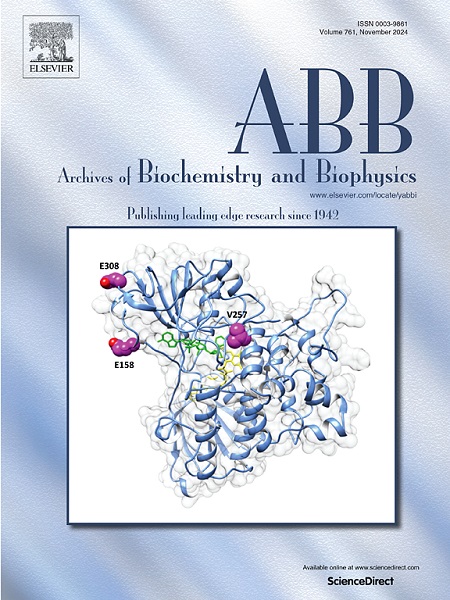异二聚体vipoxin及其单个单体亚基在RPE细胞上表现出动态的结构功能关系。
IF 3.8
3区 生物学
Q2 BIOCHEMISTRY & MOLECULAR BIOLOGY
引用次数: 0
摘要
众所周知,蛇毒磷脂酶A2 (svPLA2)是最具毒性的毒液成分之一,基于催化特异性和使用复杂分子机制影响不同组织和器官的各种非催化“药理”作用,其强大的活性令人印象深刻。在这里,我们的目的是揭示异二聚体神经毒性复合物vipoxin的单体亚基之间复杂的相互作用,以便在RPE细胞中执行多种分化和调节的生物活性。毒毒素,从蝰蛇的毒液中分离得到。由碱性和毒性分泌PLA2酶亚基(GIIA sPLA2, vipoxin碱性组分,VBC)和酸性,酶活性和无毒亚基(vipoxin酸性组分,VAC)组成。我们确定了vipoxin及其分离的单体亚基通过催化和非催化机制的组合影响两种RPE系细胞的完整性和活力。单个单体亚基VBC和VAC诱导细胞毒性,细胞骨架重排,影响上皮耐药和细胞单层完整性,触发凋亡,p38 MAPK信号通路和遗传毒性,在两种细胞系中引发非常复杂的细胞反应。VBC的催化和药理活性在RPE-1细胞系中比在ARPE-19细胞系中更明显,以浓度依赖的方式引发DNA双链损伤以及更高程度的细胞毒性(高达45%)。相比之下,非催化vac对两种RPE细胞系的膜完整性影响不显著,但对ARPE-19细胞的DNA损伤程度很高。异二聚体vipoxin在两种细胞系中均表现出复杂的动态生物学效率。总的来说,所有研究的vipoxin及其单个单体亚基的活性证明了我们的假设,即亚基之间存在复杂的动态构象和结构相互作用,提供了酶或“药理学”作用模式的即时选择,强烈依赖于RPE细胞膜组成及其微环境。本文章由计算机程序翻译,如有差异,请以英文原文为准。

Heterodimeric vipoxin and its individual monomeric subunits display a dynamic structure-function relationship on RPE cells
Known as some of the most toxic venom components, snake venom Phospholipases A2 (svPLA2) impress with their great arsenal of activities, based on catalytic specificity and a variety of non-catalytic “pharmacological” effects using complex molecular mechanisms that can affect different tissues and organs.
Here, we aim to reveal the role of the intricate interactions between the monomeric subunits of the heterodimeric neurotoxic complex vipoxin in order to perform multiple differentiated and regulated biological activities in RPE cells. Vipoxin, isolated from the venom of Vipera ammodytes ssp. meridionalis, is composed of a basic and toxic secreted PLA2 enzyme subunit (GIIA sPLA2, vipoxin basic component, VBC) and an acidic, enzymatically inactive and non-toxic subunit (vipoxin acidic component, VAC).
We established that vipoxin and its separated monomeric subunits affect integrity and viability of the cells of two RPE lines using a combination of catalytic and non-catalyticmechanisms. Individual monomeric subunits VBC and VAC induce cytotoxicity, cytoskeletal rearrangements, affect transepithelial resistance and cell monolayer integrity, trigger apoptosis, p38 MAPK signaling pathway and genotoxicity, provoking very elaborate cellular response in both cell lines. VBC uses its catalytic and pharmacological activities more pronounced in RPE-1 than in ARPE-19 cell line, triggering DNA double-strand damage as well as a higher degree of cytotoxicity (up to 45 %) in a concentration-dependent manner. In contrast, the non-catalyticVAC exhibited insignificant effect on the membrane integrity of both RPE cell lines but induced very high degree of DNA damage in ARPE-19 cells. Heterodimeric vipoxin displaced its complex and dynamic biological efficiency in both cell lines. In general, all the investigated activities of vipoxin and its individual monomeric subunits proved our assumption for the existence of complex dynamic conformational and structural interactions between the subunits providing an immediate selection of the enzymatic or “pharmacological” mode of action, strongly dependent on RPE cell membrane composition and their microenvironment.
求助全文
通过发布文献求助,成功后即可免费获取论文全文。
去求助
来源期刊

Archives of biochemistry and biophysics
生物-生化与分子生物学
CiteScore
7.40
自引率
0.00%
发文量
245
审稿时长
26 days
期刊介绍:
Archives of Biochemistry and Biophysics publishes quality original articles and reviews in the developing areas of biochemistry and biophysics.
Research Areas Include:
• Enzyme and protein structure, function, regulation. Folding, turnover, and post-translational processing
• Biological oxidations, free radical reactions, redox signaling, oxygenases, P450 reactions
• Signal transduction, receptors, membrane transport, intracellular signals. Cellular and integrated metabolism.
 求助内容:
求助内容: 应助结果提醒方式:
应助结果提醒方式:


